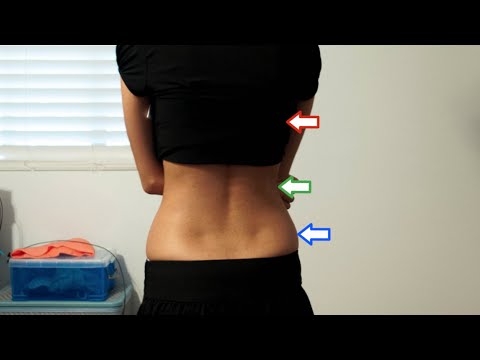
Below is a transcription of the video above – please refer to the video for all visual guides. :)
Today we’re going to talk about the dimples of Venus.
Girls can have them, guys can have them, older people can have them, babies can have them. But what are they, and how do they relate to corsets?
The official name for “Venus dimples” is actually “lateral lumbar indentations“.
Indentations = dimples,
Lumbar = lower spine,
Lateral = to the side.
The indentation is caused by ligaments pulling under the skin in that area, and it marks the sacroiliac joint – the place where your sacrum, or tailbone area, meets up with the ilium, or what I call the “wings” of your pelvis. (Because if you squint your eyes, the pelvis vaguely resembles the shape of a butterfly.)
When I was younger, someone told me that the wider a woman’s dimples, the more fertile she’s said to be. (Which isn’t exactly true – although during pregnancy, the hormone relaxin causes stretching of all ligaments in the body, but especially those of the pelvis – so it’s theoretically possible for one’s Venus dimples to become wider during pregnancy.)
Horizontally, Venus Dimples mark where you should measure your Upper Hip!
The reason I’m talking about it today is because the venus dimple, being a marker of the sacroiliac joint, is an excellent marker of where to measure your high-hip line as it’s roughly in line with your iliac crest. Even if you have a lot of padding on your hip area and can’t find your hip bone pressing down, if your Venus dimples are visible, you can use these as a marker to measure your upper hip. Remember, your upper hip is an important measurement, because the pelvic bones cannot and should not be compressed in a corset.
Vertically, Venus Dimples can tell you how long your corset should be!
Venus dimples tend to be visible right above the curve of the bum and the tailbone, which can make it a marker for how long you need the back of your corset to be. In previous videos and articles, I talked about the importance of the length of the front of the corset, and of course it’s still important – but the length of the back can also affect the comfort and fit.
Measuring from your waistline UP to the bottom of your shoulder blade (or just above your bra band) will give you a reasonable corset height that will help you avoid muffin top, while allowing good mobility of the arms and shoulders (although it’s possible to make the back of a corset even higher!).
Measuring from the waist DOWN to the Venus dimples provides the absolute minimum measurement for a comfortable corset in the back (for me, in any case) – a corset shouldn’t end above this spot. A corset can be longer than this too, but it must be able to curve over the tailbone and bum.
Corsets that stop short of the Venus dimples in the back won’t provide sufficient support for a lower tummy in the front, and corsets that extend much, much lower than the Venus dimples are likely to require bones that can curve and flex over the upper bum and tailbone area (otherwise the bones will dig into the top of your bum!). I tend to prefer my corsets to end about 2 inches below the Venus dimples – depending on the height of your bum, this might be where the butt crack starts for you.
The distance between your Venus Dimples can help you choose a comfortable ‘lacing gap’ width!
The width of the Venus dimples can also provide a good gauge for you to determine what gap width in the back would be suitable, as it can give clues to the musculature of your back. A corset with a gap far too wide may cause the steels to rest closer to your oblique muscles as opposed to your erector spine muscles, and you’re not going to get the right torque to pull your waist in.

When you’re choosing a first corset, it’s a good idea to at least have the gap in the back within the width of your Venus dimples. In the case of the model in the video, her spine is prominent (you can see the vertebrae through the skin), so it might be more comfortable for her to wear a corset with at least 1 inch gap so the corset steels aren’t grinding on her spine. Her Venus dimples are about 3 inches apart – so based on her anatomy, I’d estimate that a suitable lacing gap for a well-fitting corset would be between 1-3 inches. Incidentally, this is what many professional corsetieres recommend to begin with!
In sum: beyond just looking cute, using Venus dimples as clues can actually help you measure for a corset and predict how it might fit on you.
What do you think of the “Venus Dimple” theory for fitting corsets? Do you agree or disagree? Leave a comment below and let me know!
